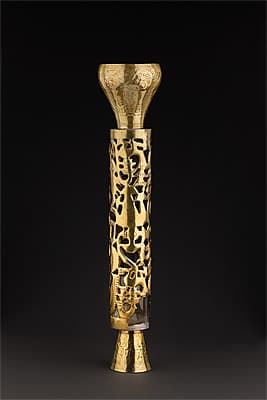
CHIMÚ culture North 1100 – 1470 AD
Ceremonial rattle beaker 1100-1470 AD gold48.0 (h) cm 9.1 cm (diameter) Ministerio de Cultura del Perú: Museo Nacional de Arqueología, Antropología e Historia del Perú, Photograph: Daniel Giannoni
The Chimú produced distinctive types of ceremonial goblets to be filled with chicha, a fermented beverage made from maize, and drunk from during rituals. The central section was made long so that it could be grasped by the priest or lord during religious ceremonies. This gesture was intended to mimic that of the Staff God, a deity worshipped by several cultures leading up to the beginning of the Chimú Empire.1
This gold cup is taller than most other ancient Peruvian ritual beakers and has been made in three distinct sections. The central body has an intricate pattern cut out of gold sheet. This pierced section displays inverted anthropomorphic figures wearing crescent-shaped headdresses from which long, plume-like shapes extend. Multiple figures are connected by the intricately cut gold work. The flared lower section forms the base, while at the other end the cup curves inwards. Both of these extremities are covered with hammered designs of fish, birds and human figures, again wearing half-moon headdresses. The central section originally contained small pieces of metal or ceramic beads that rattled during ceremonial drinking or when the vessel
was shaken.2
Simeran Maxwell
1. Elizabeth P. Benson and William J. Conklin, Museums of the Andes, Tokyo: Newsweek 1981, pp. 112, 115.
2. Antonio Aimi, cat. 63, in L’oro del Perú, Milan: Electra 2007, p. 127.
The Chimú produced distinctive types of ceremonial goblets to be filled with chicha, a fermented beverage made from maize, and drunk from during rituals. The central section was made long so that it could be grasped by the priest or lord during religious ceremonies. This gesture was intended to mimic that of the Staff God, a deity worshipped by several cultures leading up to the beginning of the Chimú Empire.1
This gold cup is taller than most other ancient Peruvian ritual beakers and has been made in three distinct sections. The central body has an intricate pattern cut out of gold sheet. This pierced section displays inverted anthropomorphic figures wearing crescent-shaped headdresses from which long, plume-like shapes extend. Multiple figures are connected by the intricately cut gold work. The flared lower section forms the base, while at the other end the cup curves inwards. Both of these extremities are covered with hammered designs of fish, birds and human figures, again wearing half-moon headdresses. The central section originally contained small pieces of metal or ceramic beads that rattled during ceremonial drinking or when the vessel
was shaken.2
Simeran Maxwell
1. Elizabeth P. Benson and William J. Conklin, Museums of the Andes, Tokyo: Newsweek 1981, pp. 112, 115.
2. Antonio Aimi, cat. 63, in L’oro del Perú, Milan: Electra 2007, p. 127.
The Chimú produced distinctive types of ceremonial goblets to be filled with chicha, a fermented beverage made from maize, and drunk from during rituals. The central section was made long so that it could be grasped by the priest or lord during religious ceremonies. This gesture was intended to mimic that of the Staff God, a deity worshipped by several cultures leading up to the beginning of the Chimú Empire.1
This gold cup is taller than most other ancient Peruvian ritual beakers and has been made in three distinct sections. The central body has an intricate pattern cut out of gold sheet. This pierced section displays inverted anthropomorphic figures wearing crescent-shaped headdresses from which long, plume-like shapes extend. Multiple figures are connected by the intricately cut gold work. The flared lower section forms the base, while at the other end the cup curves inwards. Both of these extremities are covered with hammered designs of fish, birds and human figures, again wearing half-moon headdresses. The central section originally contained small pieces of metal or ceramic beads that rattled during ceremonial drinking or when the vessel
was shaken.2
Simeran Maxwell
1. Elizabeth P. Benson and William J. Conklin, Museums of the Andes, Tokyo: Newsweek 1981, pp. 112, 115.
2. Antonio Aimi, cat. 63, in L’oro del Perú, Milan: Electra 2007, p. 127.

